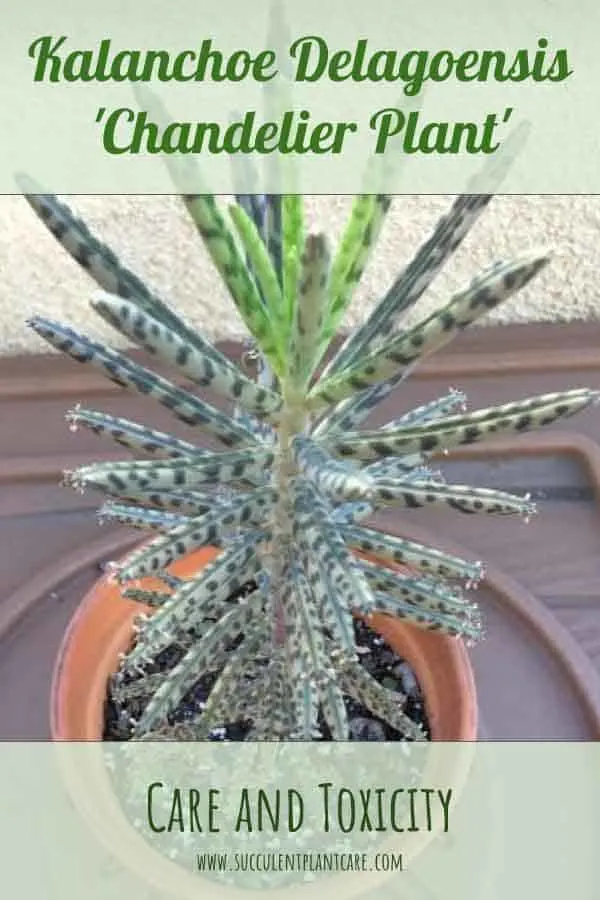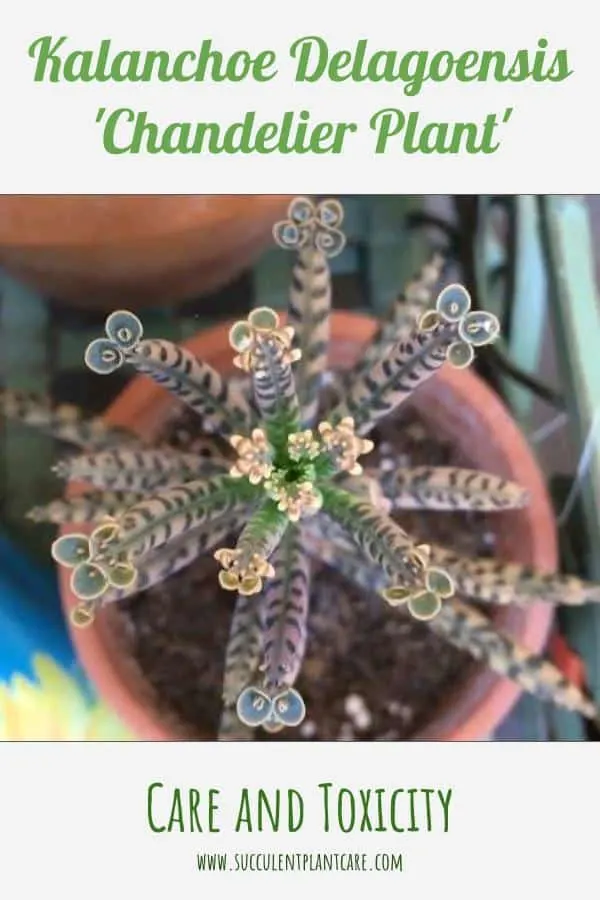Kalanchoe delagoensis, also referred to as Kalanchoe tubliflora and Bryophyllum Delagoensis, among other names, are rapid growing plants that multiply easily anywhere it lands, giving them their rightful name ‘Mother of Millions’.
They are also known by these common names: ‘Chandelier Plant’ and ‘Devil’s Backbone’. They are often confused with a similar plant, Kalanchoe Daigremontiana ‘Mother of Thousands’ which have broader and wider leaves.
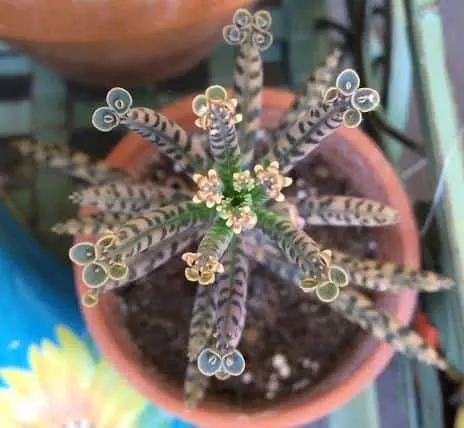
Native to Madagascar, Kalanchoe delagoensis ‘Chandelier Plant’ have thin, narrow leaves and plantlets appearing at the tips of the leaves. These plantlets are capable of growing relentlessly anywhere they land, and their seeds can survive for years even when the plants are pulled out.
These plants are not only drought tolerant, but are highly adaptable to different environments and are considered as weeds or invasive species in some parts of the world. These are not only interesting plants but are also attractive and resilient. They are easy to care for and multiply effortlessly.
Kalanchoe Delagoensis ‘Chandelier Plant’ Care
Correct me if I’m wrong, but I think it is fair to say that you will not find an easier plant to grow than these. They practically take care of themselves and propagate easily on their own. Still, it is possible to kill these plants mostly from too much love than neglect. Here are some guidelines to help you get started with these plants:
Are They Indoor or Outdoor Plants?
Kalanchoe Delagoensis ‘Chandelier Plant’ can be grown both indoors and outdoors. The three most important things for these plants are: a well draining potting mix, adequate sunlight and enough but not too much water. From my experience with these plants, they do really well outside exposed to the natural elements so if you must bring them indoors for the winter, give them some outdoor time during the warmer months and they would surely benefit from it.
USDA Hardiness Zones: Zone 10a-11b
Indoor Lighting Requirements
Place in a bright location indoors, anywhere where there is plenty of light. Try an east facing window. A south and west facing window may also work. Prepare to move the plant around a few times to find the best spot. If the plant starts to suffer from lack of light, move to a brighter location. You would know by how the plant is growing. If it starts stretching out, that means the plant is not getting enough light. This process is called etiolation. The plant is literally seeking more light. This produces weak and stunted growth.
To keep them really happy, they need approximately 4-6 hours of bright light per day. If your indoor space does not receive adequate lighting no matter where you move the plant, consider using a grow light. Grow lights can help supplement your plants’ lighting requirements especially during those long, dark winters. Here are some of my grow light recommendations.
To read more about this topic on indoor lighting for succulents, check out my post on “Proper Lighting for Succulents Indoors” to get some helpful tips.
Outdoor Sunlight Requirements
Light Shade to Full Sun. Kalanchoe Delagoensis ‘Chandelier Plant’ do best in areas that receive plenty of bright, partial sunlight. They can also tolerate full sun but needs to be acclimated to full sun in the beginning to prevent sunburn. Their color turns a darker shade of grayish-purple with dark spots when exposed to more sun. You will also notice increased spotting on the leaves when exposed to more sun.
Before moving the plant outdoors or increasing the amount of sunlight it receives, it is better to acclimate the plant by gradually increasing the amount of sunlight it receives until it is fully acclimated to the more intense sun. Keep in mind that even when the plant is already acclimated to full sun, it can still get sunburned during a heatwave or intense heat. The leaves will thin out and dry up under intense heat.
Sunshades are a real lifesaver for my plants during the intense summer heat here in Northern California where the temperatures can rise above 100℉ or 37.8℃. Here are some of my recommendations for sunshades and sun protection.
For further details and information on outdoor sunlight requirements, please visit my post “How Much Sunlight Do Succulents Need Outdoors?” to get some useful tidbits.
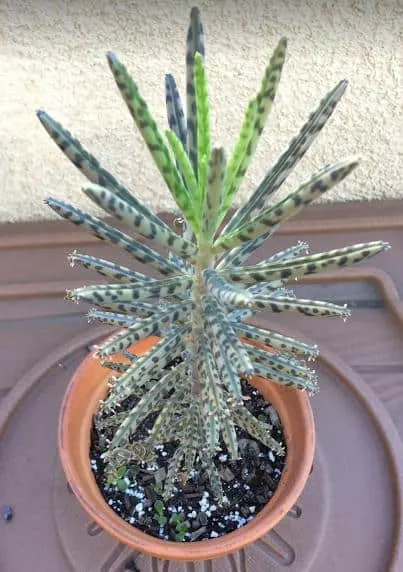
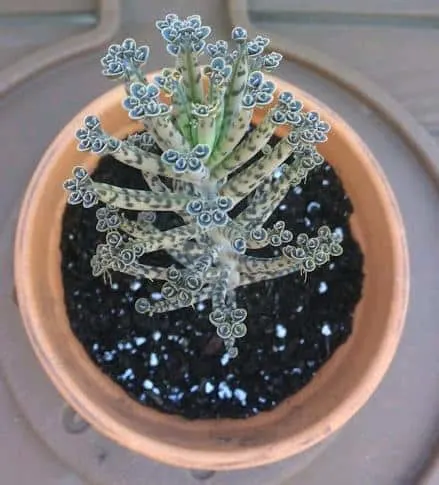
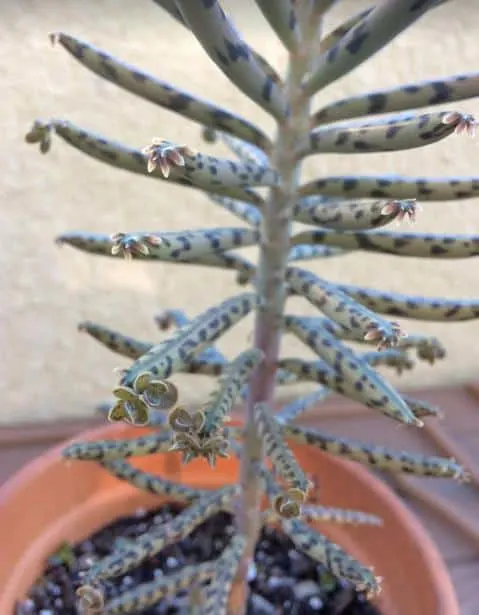
Frost Tolerance
Kalanchoe Delagoensis ‘Chandelier Plant’ can tolerate mild frost and slightly freezing temperatures but only for short periods of time. If you live in USDA hardiness zones 10-11, you can get away with leaving the plant outdoors all year long. I have kept mine outdoors all year long, and they survive the freezing rain and frost we experience in winter time mainly because of all the bright sun we receive during the day. But there are days when I need to protect my plants from the sudden drops in temperature.
For those people living in areas with extreme winter conditions, the best way to grow these plants is in containers. That way you can bring them indoors during winter or when there is forecast of frost or snow. In case you can’t bring your plants in, there are ways to protect them from frost and freezing temperatures outdoors. You can use frost cloths or mini greenhouses to help them survive the cold winter. Here are some of my recommendations for frost protection.
For further tips on this topic, check out my post on “Optimal Temperatures For Succulents to Survive and Thrive”.
Soil Requirements
Kalanchoe Delagoensis ‘Chandelier Plant’ are hardy plants that are known to grow anywhere and survive harsh conditions. I’ve even heard of stories of these plants growing through concrete. But to ensure success, Kalanchoe Delagoensis ‘Chandelier Plant’ needs a well draining soil. The right type of soil goes hand in hand with proper watering. I like to use a simple, tried and tested mixture that has worked well for all my succulent plants. I use cactus potting mix combined with perlite for added drainage. I eyeball it to about 2:1 solution of cactus mix and perlite. You can also consider making a sandy soil, which adds more drainage to the mix. This can be achieved by mixing cactus mix or potting soil with coarse sand (about 2:1 ratio). Or you can use a combination of the three materials mentioned: Cactus mix, perlite, coarse sand (1:1:1).
I get most of my materials from a local hardware store. You can also purchase them online. Here are my soil recommendations. To read more about soil for succulents, click on “Best Soil and Fertilizer for Succulents” to get more useful information.
Watering Requirements
Watering largely depends on the climate you live in. Although these plants are highly adaptable, they thrive when given just enough but not too much water. There really isn’t a set schedule or formula on when to water succulents. My watering schedule is dictated by the very dry climate I live in.
In the summer months, I water my Kalanchoe Delagoensis ‘Chandelier Plant’ as often as every 7-10 days. I cut back on watering to about every 10-14 days when the weather cools down during spring and fall seasons. During the winter season, I rely mostly on rainwater and hold back on watering altogether because this is when we get a lot of rain in my area. But if we don’t get any rain at all during winter then I water at least once a month or every 2-3 weeks, depending on how dry the soil gets.
For those people in humid locations, you won’t need to water as much. And if you keep your plants indoors, you may not have to water as much especially if they are not receiving a lot of light. Too much water and not enough light is a recipe for disaster for these plants.
One good way to tell whether it’s time to water is to check the moisture of the soil. The top inch of the soil needs to feel dry before you can water again. If you are unsure how much and how often to water in the beginning, it’s always better to underwater and increase watering as needed. Pay attention to how your plant looks and you can adjust watering accordingly.
For further help with watering techniques, consider using tools like hygrometers or moisture meters to check for moisture in the soil and air. These tools are pretty affordable and can come in handy especially if you are unsure of when to water your plant next. I have narrowed down the choices here on my resource page. Do visit the page if you need help in gauging your watering needs.
Interested in finding out more about watering succulents? Visit my post “How And When To Water Succulents” where I go into more details about this topic.
Propagating Kalanchoe Delagoensis ‘Chandelier Plant’
Kalanchoe Delagoensis ‘Chandelier Plant’ propagates easily on its own. You really do not need to do much as it will do the work for you by itself. You just need to wait and see, and you wouldn’t even need to wait that long. It propagates by dropping the little plantlets or baby plants that grow on the tips of the leaves. These little plantlets will root and grow wherever it lands (literally everywhere). Their seeds are also known to survive long after the plants are pulled out. In reality, you probably need to keep an eye on this plant to contain it and prevent it from growing and taking over your entire garden.
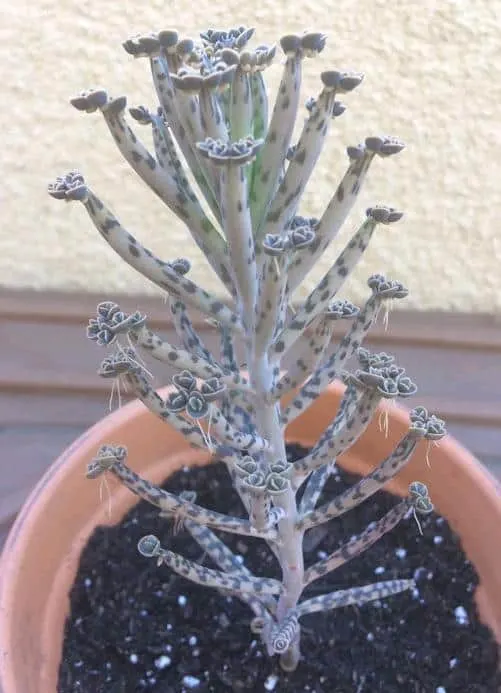
These little plantlets attached to the tips of the leaves are rooting and ready to go. They will drop on their own and root wherever they land. They are known to grow anywhere, even on concrete.
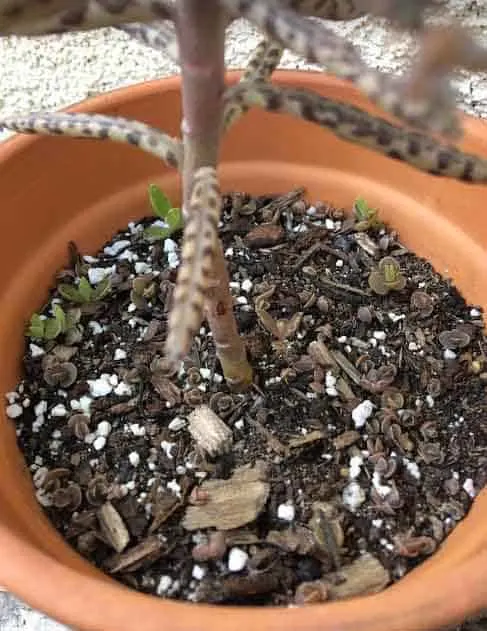
Plantlets that have dropped on their own and landed on the soil, next to the mother plant. Some of them I have found on the ground and have placed back in the pot.
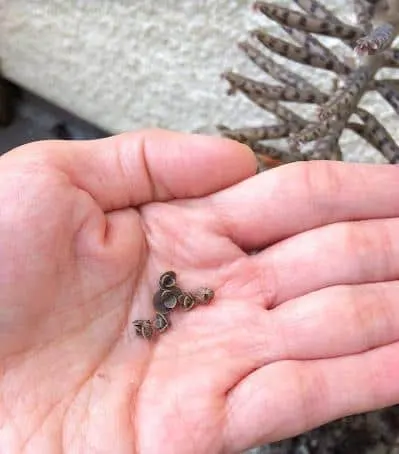
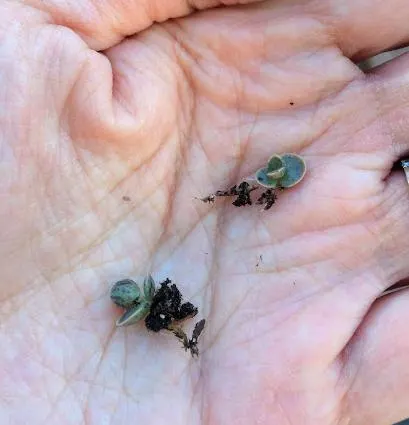
I keep finding these little plantlets in surrounding pots, even a few feet away from this plant. I imagine they get blown there by the wind. I pull them out whenever I see them growing in another pot. If you do not want them growing in other pots along with your other plants and potentially choking the weaker plants, I suggest keeping this plant in its own pot and some distance away from your other plants. However, if you do not mind them at all, then you can easily spread this plant around with little or no effort on your part. Trust me, all you need to do is wait and you will see what I mean.
Likewise, if you do not know how your other plants will do when planted with these, I suggest planting your other plants separately and keeping these in their own pot. Again, this is more of a personal choice. I know others that have planted Kalanchoe Delagoensis ‘Chandelier Plant’ in the same pot as other succulent plants with no problem.
If you can’t wait and want to help with the propagating process, you can propagate them through stem cuttings. I have not heard of this plant being propagated through leaf cuttings, but at the rate that it propagates itself through the little plantlets, you would not want to bother with leaf propagation in the first place.
How To Propagate Kalanchoe Delagoensis ‘Chandelier Plant’ from Stem Cuttings:
- Obtain a stem cutting and let it dry for a day or so. Let the cut ends dry and callous or seal.(Optional) Dip the cut end in rooting hormone. I usually skip this step but some people prefer using rooting hormones to speed up the process and also guarantee success.
- Once the cut has healed and dried, stick the cuttings in a well draining potting mix.
- Keep away from direct sunlight. Water the soil every few days or when it feels dry.
- After about two weeks or so, you will notice new roots growing.
- After about four to six weeks, the cuttings should be fully rooted and you will soon notice new growth developing from the top or the sides of the stem.
Once fully rooted, cut back on the misting and switch to regular watering about once a week or less. Increase the amount of sunlight as the plant matures.
Common Problems with Growing Kalanchoe Delagoensis ‘Chandelier Plant’
Brown Leaves
The most common cause is sunburn. This can often be from the more intense afternoon sun and during a heatwave. Simply move the plant to a shadier location to prevent sunburn when you expect the temperature to rise above normal. Sunburn spots on the leaves are permanent but does not really hurt the plant internally, as long as the problem is corrected. You can trim the brown, sunburnt spots off or wait for new growth to develop.
Mushy Leaves
The most common reason for mushy brown leaves is overwatering. The plant will look unwell and the leaves will get soft and mushy and appear lighter or translucent. These are telltale signs that you are overwatering your plant. Cut back on watering and allow the plant to dry out and recover from too much water. Do not water until the plant has had a chance to dry out completely. If the soil is not drying out fast enough, consider switching to a fast draining one. Root rot can develop when left in wet soil. Once you notice rot, you can still save the plant by cutting off the dead parts of the plant. Save anything that looks green and viable to propagate and repot.
Dry, Shriveled Leaves
The most common reason for dry, shriveled leaves is underwatering. These plants do not need a lot of water but once their water storage runs out, you will notice the plant looking stressed. The leaves will appear thin, dried up and shriveled. Simply water the plant thoroughly and it should perk right up within a day or two.
Remember, it is easier to ‘fix’ an underwatered plant than an overwatered one so when in doubt, err on the side of caution when watering especially if you are not familiar with the plant.
For more on this topic, check out my post where I describe the common causes and solutions for leaf discoloration in “Why Do Succulent Leaves Turn Brown, Yellow and Black?”.
Kalanchoe Delagoensis ‘Chandelier Plant’ Blooms
Kalanchoe Delagoensis ‘Chandelier Plant’ produces showy bell-shaped flowers that are coral pink and orange in color. While it’s always a treat to see my succulents bloom, keep in mind that not all plants are ready to flower, and some may not bloom at all. A lot of it depends on environmental factors beyond our control.
To encourage blooms, make sure they are receiving adequate lighting. Along with proper lighting, make sure the plant is kept happy and receiving the proper care as mentioned above.
While fertilizing is not necessary, giving your plants the nutrients they need will help ensure proper growth and encourage blooms. It takes a lot of energy for plants to produce flowers, and feeding them extra nutrients will help supplement their needs during flowering season. The best time to fertilize is during the active growing season, or during spring and summer months. A balanced blend of fertilizer for houseplants or a fertilizer specially formulated for cacti and succulents are suitable. Fertilizers are better applied at a quarter or half strength, about every two weeks. Here are some fertilizers I recommend.
Along with the right environmental conditions, they also need to go through a wintering period to encourage blooms. This can be achieved by keeping them cool and dry in the winter months, with temperatures just above freezing between 35-44⁰F (1.5-7⁰C).
Kalanchoe Delagoensis ‘Chandelier Plant’ Toxicity to Cats, Dogs, and Pets
According to the ASPCA and the pet poison helpline, Kalanchoe Delagoensis ‘Chandelier Plant’ are considered toxic to pets. Kalanchoes contain cardiac toxins (bufadienolides). The level of toxicity is generally mild to moderate and rarely severe. When ingested by dogs and cats, the most common symptoms are gastrointestinal irritation or upset. If large amounts are ingested, there is a higher risk of more severe symptoms such as changes in heart rate and rhythm. When in doubt, do not leave this plant near pets. If you suspect poisoning, contact your local veterinarian immediately or the ASPCA Animal Poison Control Center at 888-426-4435.
Kalanchoe Delagoensis ‘Chandelier Plant’, ‘Mother of Millions’ are not only unusual, they are also a lot of fun to grow. If you are looking for a hands-off plant that is hard to kill, I highly recommend these plants. They will thrive under most conditions, but will do especially well under neglect.
Related post that you might find helpful: “Mother of Thousands or Mother of Millions?”
Where can you find Kalanchoe delagoensis ‘Chandelier Plant’? Check out my resource page for recommendations on where to purchase these and other succulent plants online.
Pin this to save for later or to share with others!
